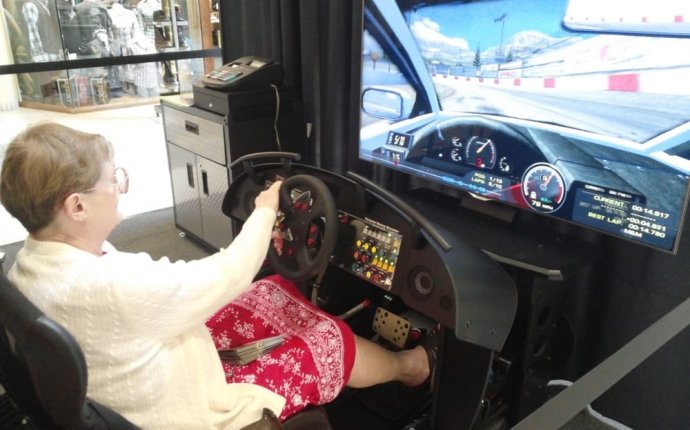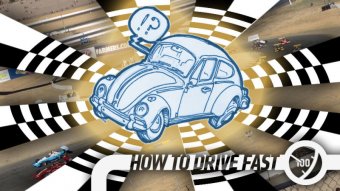
Learn to Drive a Race Car
 (Full Disclosure: Simraceway was so disgusted with my general lack of track driving skills that they let me take this class for free, as long as I found my own way up there. I did, in a press-car V6 Mustang, and I got a speeding ticket on the way there. The cop didn't like it when I told him I was an auto journalist, saying "I see. You write about how fast cars go so every idiot can go out and drive them fast?" I was boned.)
(Full Disclosure: Simraceway was so disgusted with my general lack of track driving skills that they let me take this class for free, as long as I found my own way up there. I did, in a press-car V6 Mustang, and I got a speeding ticket on the way there. The cop didn't like it when I told him I was an auto journalist, saying "I see. You write about how fast cars go so every idiot can go out and drive them fast?" I was boned.)
The class I took was a special event for winners of a contest held in the Simraceway community. So, the people I was with were from all over the world — Spain, Poland, New Zealand, Narnia, California — and all were excellent at the high-end racing sim that got them out to Sonoma. Except me. I'd never actually played it, but it sure looked impressive.
Some of the winners had some real track experience, and a good number had a lot of karting experience, which is how almost all real racers start. Even their computer-based racing experience proved useful for learning tracks, finding the ideal lines through turns, and helping to train your eyes and reflexes.
In other ways, the simulator is useless. Nothing can replicate the physical feel of the car in a hard turn, and you can't exploit physics in the real world without some serious health-and-money related consequences. All in all, more realistic simulators like Simraceway do seem to help a little bit, at least, so if you needed another excuse to play, there you go.
Normally, our How To Drive Fast columns are written by genuinely fast people like Alex Lloyd, but I thought there should be at least one of these that covers the subject from an unskilled perspective. And boy am I qualified to do that. Despite how incredibly well we all drive on the racetracks located inside our craniums, I suspect that I'm not alone, and there's a good number of readers interested in more competitive track driving but who just never had the time or resources to really give it a try. This is for you.
For the vast number of you who know more than I do, I'm looking forward to your suggestions down there in Kinja, and the painful ache of shame in my stomach when you inevitably call me out on some woefully wrong bit of advice.
So, here's the six big things I took away from racing school. I think the fact that these seem to be the ones that stuck with me must mean something, right?
1. Imagine a string tied from your steering wheel to your gas pedal.
This is one of the most fundamental pieces of advice I got about driving fast, and it seems obvious once you hear it, but thinking about it while driving makes a big difference. Essentially, what this business of strings tied to gas pedals means is that you can only really go fast when your wheel is straight. If the wheel is cranked far in one direction or the other, your string will be tight on the gas pedal, and you can't push it much. When the wheel is straight, there's plenty of slack, so you can stomp that gas.
Lots of gas with your wheel cranked will usually just get you in trouble. So, you let up in the turns, and bury it in the straights. As you're driving, keep imagining that string, and you'll be surprised how much easier it is to adjust your throttle to what your car is actually doing.
2. Brake hard and early.
This one was a bit counter-intuitive, and goes against how most of us have been trained to drive all our driving lives. Track driving is not like street driving, and this is one of those things that drives that point home. My instructor suggested that when you get to the braking point of your turn, right before your turn-in point, you need to hit the brakes hard and deliberately — with about 80%-90% of full braking force, then gradually let off the brake as you go through the turn.
This does two things: first, it slows you down before you get in your turn, pretty dramatically, and second, by gradually letting off the brake it keeps the front of the car planted, since your car will tend to nose-down while braking. This is essentially trail braking, and it helps your front tires, which are doing the steering, maintain good contact with the track so the turning actually works.
Slamming on the brakes hard as you approach the turn feels strange at first, since in most people's driving experience, that sort of stop equates to panic. Once you get past those feelings, it quite fun.
3. Hands at 9 and 3.
Now, don't let go. Even if your arms get all twisted.
In some ways, this one is the hardest to get used to, but it makes sense. Essentially, in track driving, you'll grab that wheel at 9 and 3 (not 6 and 7 like my preferred relaxed driving method) and keep those hands there. That means no letting the wheel slide through your fingers, no hand-over-hand. Your hands stay on the sides of the wheel.
GIF
This gets weird-feeling because at some points your arms will be crossed over each other like a challah or a French braid, and that just feels wrong. But it's not — in fact, look at that GIF there — I saw that this method is exactly what Tiff Needell uses when I was out with him at Willow Springs in a modified 911. If it's good enough for Tiff...









